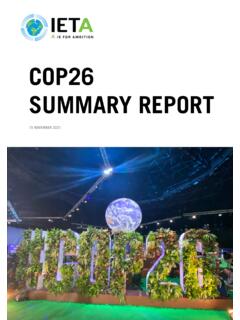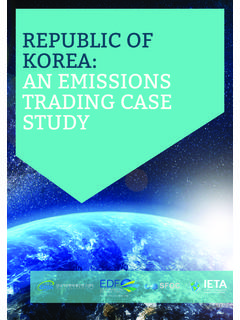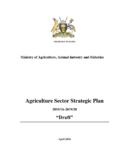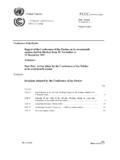Transcription of A VISION FOR the market provisionS of the paris …
1 1 A VISION FOR themarket provisionS of the paris agreement 2 A VISION for the market provisionS of the paris agreement May 2016 IETA Rue Merle-d'Aubign 24, 1207 Gen ve, Switzerland 3 Executive Summary To limit warming to well below 2 C, emissions mitigation must scale up to a world of net zero1 emissions in the second half of the century, or in little as 35 years2 to achieve the C goal. An important next step in advancing the paris agreement is the acceleration of adoption of carbon pricing. Many business leaders and government officials urge the use of carbon pricing as the most effective policy instrument in directly tackling emissions. Article 6 of the agreement provides a foundation for international cooperation through markets, with the value of carbon pricing incentives noted in paragraph 137 of the decision text.
2 The creation of carbon pricing systems and the transfer of units between them can direct large scale financing towards the most effective mitigation activities whether sector level or project based. The broader the base for a given carbon price, the more efficiently it operates and the lower the overall cost of managing emissions to the economies within which it is operating. So, international links between markets can achieve even deeper cuts and assist the transfer of significant climate finance to help fund NDCs of interested developing economies. Article 6 of the paris agreement provides the opportunity to expand the reach of carbon pricing to enable full implementation of Nationally Determined Contributions (NDC). Its development should be guided by the fundamental principles of ensuring environmental integrity and avoiding double counting.
3 Article 6 has two key features: 1. It describes the use of internationally transferred mitigation outcomes (ITMO). The concept of exchange ofcarbon units, either notional or real, should be an underpinning feature of any ITMO to ensure It establishes a mechanism to contribute to the mitigation of greenhouse gas emissions, or an EmissionsMitigation Mechanism (EMM), and support sustainable development. The EMM, in conjunction with the ITMO,could be designed to promote carbon pricing. With the full implementation of the paris agreement , the EMMcould offer a universal carbon allowance or credit for those countries that choose to use it, facilitating tradebetween NDCs ( ITMO), providing registry facilities and therefore offering the prospect of carbon pricing inmany economies. This in turn could channel additional investment.
4 Therefore, IETA recommends a broadinterpretation of Article and having an open framework that will help governments account for emissionreductions offers this straw-man VISION for Article 6 implementation as a basis for discussion over the coming months with a view to towards more widespread adoption of carbon pricing. 1 Referred to in the agreement (Article 4) as: to achieve a balance between anthropogenic emissions by sources and removals by sinks of greenhouse gases in the second half of this century 2 Energy system transformations for limiting end-of-century warming to below C, Rogelj et al, Nature Climate Change, June 2015 4 BACKGROUND The paris agreement will likely set the stage for action on climate change into the second half of the century, if not much longer. During that time the agreement must operate on a scale commensurate with the energy, forestry and agriculture systems and be sufficiently robust so as to deliver a sharp drop in global emissions.
5 While the Kyoto Protocol operated on an economy wide basis in a limited number of countries and at a relatively small scale in all others, the paris agreement must completely transcend this in order to realize the ambition embedded within it. Economy-wide action must become the model, both through large scale sectoral and project activity. Over the same period and largely for reasons of scale and reach, we would expect to see further development of carbon pricing systems and instruments at national level as countries implement their Nationally Determined Contributions (NDCs). In order to limit competitiveness concerns and to facilitate global trade without distortionary influences, these systems should harmonize and eventually converge, such that a single prevailing carbon price begins to emerge.
6 Although that process may take many years, it is the expected direction of travel. Economic theory also argues for market harmonization in that the broader the base for a given carbon price, the more efficiently it operates and the lower the overall cost of managing emissions to the economies within which it is operating. Harmonization of systems can come through linking of national carbon pricing systems, which in turn requires accounting for the transfers that result. In particular, strong provisionS will be required to avoid double counting and ensure that any exchange of units units is correctly accounted for in national inventory reporting. An important next step following on from the paris agreement and as noted in paragraph 137 of the decision text, is for the acceleration of adoption of carbon pricing, recognizing the effectiveness of this policy instrument in providing incentives to reduce emissions.
7 The creation of carbon pricing systems and the transfer of units between them can also direct large scale financing towards mitigation activities. During the first period of the Kyoto Protocol, the use of the CDM, even at modest scale, directed tens of billions of dollars of finance to projects in emerging economies. Likewise, the voluntary carbon market has also directed significant additional dollars to similar projects, albeit often in other sectors such as forestry and agriculture. Within the context described above sit the carbon trading or market -based provisionS of Article 6 of the paris agreement . The Article (see Annex 1) also caters for a non- market based approach, which may complement the market -based approach but is not within the scope of this paper. N A T I O N A L L YD E T E R M I N E D CONTRIBUTIONS (NDC) All Parties to the paris agreement are required to communicate NDCs.
8 For all Parties, this represents a future emissions trajectory, typically five to ten years. This is equally true for countries that have submitted a series of actions that comprise their NDC, as it is for countries that have specified a particular emissions target where a carbon emissions trajectory can be derived. In its initial INDC assessment report3, the UNFCCC Secretariat determined the effectiveness of the pre- paris INDCs emissions3 Synthesis report on the aggregate effect of the intended nationally determined contributions, FCCC/CP/2015/7, para. 83 5 paris INDCs in terms of deviation from a business as usual emissions trajectory, even though this level of detail wasn t provided by all the 119 submissions they had at the time of the assessment. Several countries stated in their INDCs that the level of commitment they are putting forward is conditional upon having access to international carbon markets in the paris agreement .
9 Overall, 91 INDCs mention the use of markets. In the context of emission trajectories, there are three archetype NDCs that could be considered; Fixed Economy Wide Emissions Pathway (Type 1): This is an NDC based on a specific emissions target. For example, the economy is at 100 emission units in some reference year and has a trajectory that takes it to a new point of emissions in a future year. The total number of units between the two years represents a fixed emissions limit that should not be exceeded. There is a comprehensive national GHG inventory and international reporting system in place which tracks emissions and could incorporate carbon unit trade. Examples of Type 1 NDCs include the European Union, the United States, Brazil and Japan. Anticipated Economy Wide Emissions Pathway (Type 2): This is an NDC based on a desired emissions trajectory, which may be expressed as a deviation from business as usual, an emissions intensity at some future date, or simply a peaking year.
10 For example, an economy may be expecting a certain rise in emissions over the forward period, but anticipates a different outcome subject to the full full implementation of its NDC. There are two emission limits to deal with; the first is the limit related to the projected or business as usual rise in emissions over the forward period. The second is the limit associated with the anticipated or target outcome itself and can be converted into an absolute emissions limit over the period. The country in question may not have a robust GHG inventory, in which case the opportunity for economy wide carbon trading may initially be limited. It is possible, however, for a national emissions trading system to use a fixed baseline and reduction target for some sectors within a Type 2 NDC.







